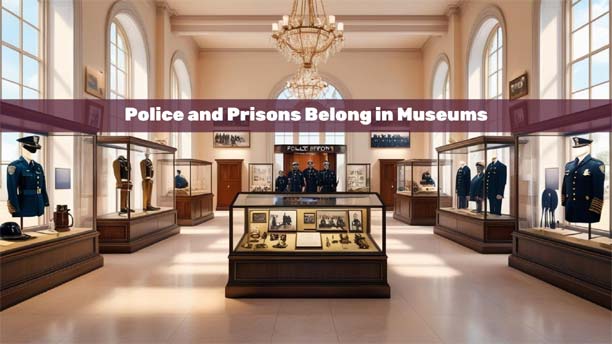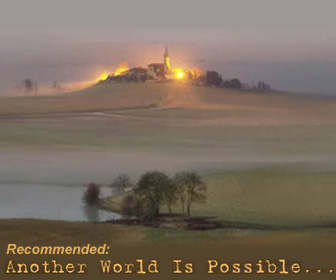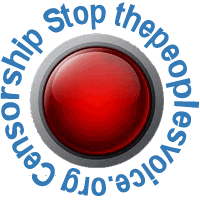| « The Tail Wagging the Dog: How Israel Controls U.S. Foreign Policy | DarkBART & DarkBERT: The Dark Web Pre-Crime Machine Learning Models » |
Police and Prisons Belong in Museums
By David Swanson, World BEYOND War
I want to recommend three new books about abolishing police and prisons. And I want to recommend multi-issue abolitionism beyond those two institutions.
What else would I abolish? Well, a list might start with war, fossil fuels, militaries, prisons, nuclear energy, police, nuclear weaponry, campaign bribery, health insurance companies, the death penalty, the livestock industry, Wall Street, borders, poverty, the NSA, the CIA, the United States Senate, Fox News, MSNBC, the Star Spangled Banner, the cyber truck. I could go on. Lists will vary around the world.
By abolitionism I mean, primarily, persuading masses of people of the superiority of a new way of doing things, and effecting the political changes to create that new way of doing things. You can’t get rid of police or prisons or wars or Fox News by blowing up a building or zeroing out a budget, if people are all left believing that they need or want those institutions. The darn things will quickly be back stronger than before.
Persuading people that there is a better way than police or nukes or oil is a major project. Persuading them of several of these things at once may sound dramatically and senselessly more difficult. On the other hand, many of the same arguments that apply to one topic apply to several others. The survival of life on Earth actually requires a sort of panabolitionism. And if we were ever to combine the energies of all the people who each want one destructive, counterproductive institution abolished, together we’d have a lot of power.
The new books I have in mind are Talking About Abolition: A Police-Free World Is Possible by Sonali Kolhatkar; Skyscraper Jails: The Abolitionist Fight Against Jail Expansion in New York City by Jarrod Shanahan and Zhandarka Kurti; and No Cop City, No Cop World: Lessons from the Movement by Micah Herskind, Mariah Parker, and Kamau Franklin. These books are not the persuasive case for abolition, so much as accounts of the struggles of activists who work for abolition or for steps toward abolition. There are such things as partial steps toward abolition, just as there are such things as false steps that do not lead in that direction (even if they pretend to).
In Talking About Abolition, Cat Brooks is quoted as saying that “the data and the logic” establish that housing, mental health support, living-wage jobs, healthcare, and education reduce violent crime more than police and prisons do. But of course that doesn’t strike some people as “logic” at all. So the data becomes very important, including international and regional comparisons. One good source of data — here — establishes overwhelmingly that moving at least part of what gets spent on prisons and police into other programs would accomplish more, not less, of what prisons and police claim to be for, namely reducing violent crime — programs such as trauma assistance, hospital case workers, mentoring, training, jobs, courses on preventing sexual violence, and such as summer jobs, financial support, sports, positive parenting, early childcare, etc. The reason why it’s “logical” that general investment in better lives reduces crime more than police and prisons do, is in part because so many crimes arise out of misery, and in part because places that have made those investments tend to have less violent crime than places that have invested instead in police and prisons.
This is not a new discovery, or a truth that simply sets us free. There are a couple of major longstanding hurdles. First, U.S. city budgets often devote a huge percentage to police, and the primary reason seems to be antidemocratic corruption by profiteers, moneyed interests, and police unions. All of this is, of course, a perfect parallel to a national government’s war spending and its causes.
Second, just as when someone hears about war abolition they want to know what to do when Hitler comes to get them, when someone hears about police abolition, they want to know whom they should call in an emergency. Cat Brooks’ answer that you should deal with it yourself or “hush” is not likely to persuade everyone.
As with war, so with police, a major part of the answer will strike the skeptic as evasive. If you demilitarize the world, if you establish the rule of law, if you create nonviolent conflict resolution mechanisms, if you set up populations with training in unarmed civilian defense, if you get rid of the weapons, etc., life on Earth might survive and even prosper with the redirection of resources, and Hitler (long since dead, by the way) won’t get you. If you eliminate poverty, create universal public healthcare, provide free quality education from preschool to college, and ensure safe and stable lives for all, not to mention — and, surprisingly, it is hardly ever mentioned in abolish-police books — getting rid of the hundreds of millions of guns in the United States alone, the kind of emergency in which you’d want to call the police won’t come up.
But what if it does? Even if it’s as rare as lightning? What if it does and I have nightmares about it until it does? That’s where unarmed civilian defense, and nonviolent interrupters and de-escalators come in. There are, in fact, other ways to non-destructively prepare to confront that which may no longer need confronting. And these other methods will become both more understandable and less needed as partial steps toward abolition are taken.
In fact, one of the successes underway by police abolitionists is the establishment — already achieved in a number of U.S. cities — of alternative numbers to dial in emergencies, at which you can reach skilled providers of assistance with mental health, de-escalation, and other needs, and to which you can specify what kind of assistance you do or do not want. Other paths to success would seem clear if we had democracy. As with the federal budget and the Pentagon, so with local budgets and the police: when you show people what budgets look like, the majority of people want to move money out of the police and the Pentagon into useful things. The trick lies in building the power to make that majority will into governmental action.
While Talking About Abolition provides inciteful interviews with a dozen remarkable activists and academics, Skyscraper Jails and No Cop City each focuses on a particular campaign, respectively the efforts to close the jail on Rikers Island in New York City and to prevent the construction of the Cop City militarized police training facility outside Atlanta. The two campaigns have faced fierce opposition. To grossly oversimplify, the New York opposition has been slicker, slimier, more dishonest, and more successful. An astroturf campaign has been created in New York, not to oppose prison closures or abolition, but to claim the title of Abolitionist, even while pushing for new multi-billion-dollar jails in skyscrapers to “replace” Rikers, even while not closing Rikers at all, even while maintaining that these are all steps toward eliminating prisons. As you might have guessed, not everyone has fallen for that sales pitch, and a good deal of corrupt anti-democratic action has been required as well.
Nonetheless, the project of building a New York skyline of humans in animal cages stacked into the clouds has generally operated under the banner of “Close Rikers,” generating — it is my impression — less indignation around the country and world than has been merited and than has been gained by the resistance of the forest defenders opposing the creation of Cop City.
False steps that lead not toward abolition but often toward the strengthening of a destructive institution sometimes rely on distinguishing good prisons or wars or whatever from bad. In the case of wars this habit is strong even among passionate opponents of wars.
The problem with Rikers is not that it is an improper prison — though who wouldn’t choose a prison in Scandinavia if they had a choice? — just as the problem with Gaza is not that it is an improper war — though you might take your chances in Yemen if forced to pick. The problem with Rikers is not that it’s on an island or that it lacks some new technology. The problem is that Rikers puts people, some convicted of crimes and many (83% in 2023) not, in cages to dehumanize and brutalize them to no useful purpose. As Rikers began as a humane reform of an older prison, skyscraper prisons are now marketed as a humane reform of Rikers. But the whole system is incapable of humaneness.
One of the best features of Skyscraper Jails is that it quotes some of the powerful comments residents of New York City submitted to public officials who were required to pretend to seek public input but listened not a bit. Now we can listen for them.
One of the worst features of Skyscraper Jails is near the end of the book, where the authors claim that “there will be no peaceful transition” and “strife” will be required “equaling at least that of the French Revolution, guillotines and all — just as the abolition of slavery and realization of formal equality for Black people required a great, bloody, civil war.”
Fun times ahead, folks! At least for propagandistic nonsense. Some three-quarters of the world rid itself of slavery and serfdom within a century, much of it without a “great, bloody, civil war” which most certainly did not bring the degree of formal or informal equality brought by the Civil Rights movement. We should look to the wisdom and coherence of Ray Acheson’s book Abolishing State Violence: A World Beyond Bombs, Borders, and Cages, in which war is one of the institutions to be abolished.
It’s disconcerting to read that what needs opposing is “organized violence” but not war, or to see incarceration defined as “warfare,” but, you know, warfare not opposed as warfare. This pattern may provide a clue to the absence of the guns from these books. No Cop City, No Cop World is explicit about its support for property destruction, while hinting at openness to supporting serious violence, but never bringing up guillotines or civil wars. This topic, which I suggest is critically important, is, however a very small part of these excellent books. One of the reasons it is important is the need to build larger movements through bringing in large numbers of people who are mostly opposed to violence. Another reason is the need to grow stronger by combining the movements that oppose wars, prisons, police, etc. They have much to learn from each other in addition to creating larger numbers through joining together.
No Cop City gives us a rich understanding of the history, context, and players in the struggle in and outside Atlanta, as well as lessons that could prove very valuable for similar struggles in numerous other places. Cop City is not a national project but a model for a militarized war rehearsal ground coming soon to a metropolitan area near you. The book also makes clear the connections to war, the training of police by the Israeli military, the military equipment and language and thinking. Atlanta is our most unequal and most surveilled U.S. city with one of the deepest traditions of racism. But as it does, so others will follow.
And as the inspiring opponents of Cop City go, others should follow as well. While I question acceptance of all tactics, no matter how counterproductive, as the supreme activist value, I cannot help but marvel at the tremendously broad coalition (lawyers and children and campers and voters and protesters and saboteurs and a native American nation and environmentalists and peace activists and Central Americans, etc.) and variety of approaches that have taken on Cop City and at least partially and temporarily stopped it in its tank tracks. This is a movement — in the tradition of Occupy — with direct democracy, consensus, and a modeling of a better society on a smaller scale — a life-changing experience in multiple senses.
Imagine a world of growing numbers of encampments dedicated to creating a life without poverty, cruelty, or violence — with no exceptions, no exceptions for certain types of victims, no exceptions for violence on a large enough scale, no exceptions for structural violence hidden in systems of denial of healthcare or a safe environment, no exceptions for people labeled “felon” or “enemy” or “foreigner.” Does abolition sound like a “negative” idea? Think of the world it could give birth too and just try not to smile.
-###-
Police and Prisons Belong in Museums
https://worldbeyondwar.org/police-and-prisons-belong-in-museums/
David Swanson is an author, activist, journalist, and radio host. He is executive director of WorldBeyondWar.org and campaign coordinator for RootsAction.org. Swanson's books include War Is A Lie. He blogs at DavidSwanson.org. He hosts Talk World Radio.




